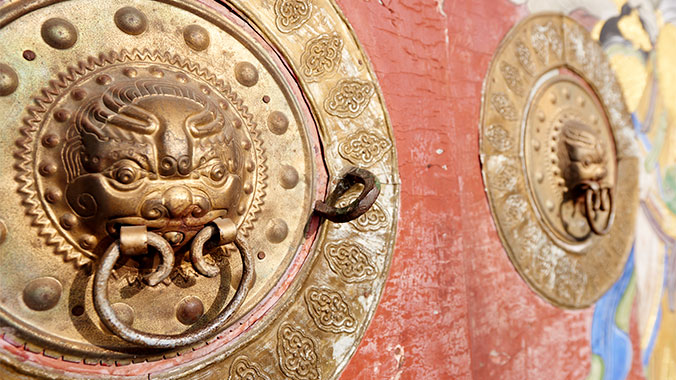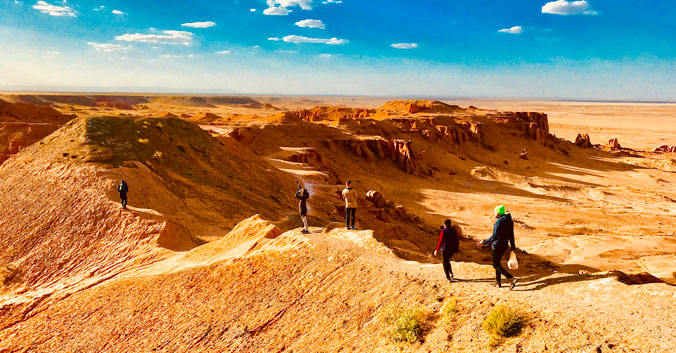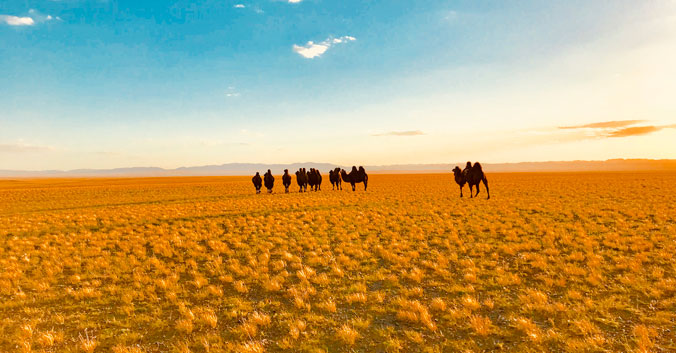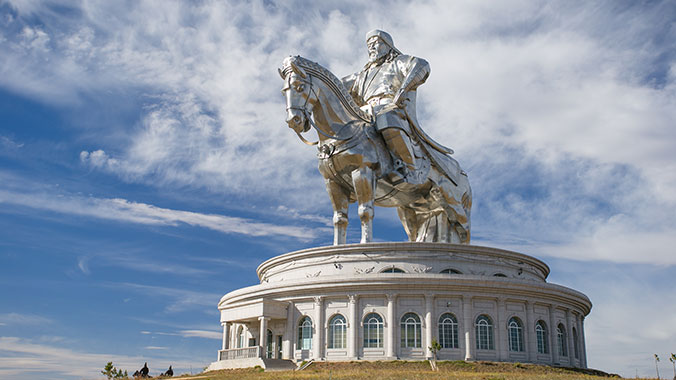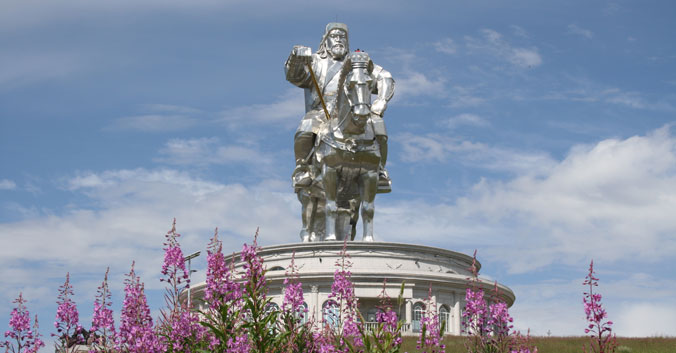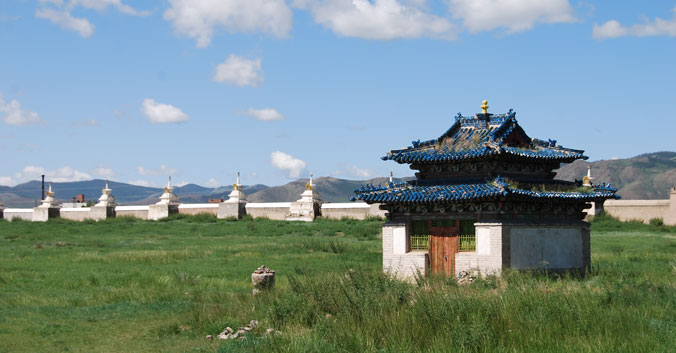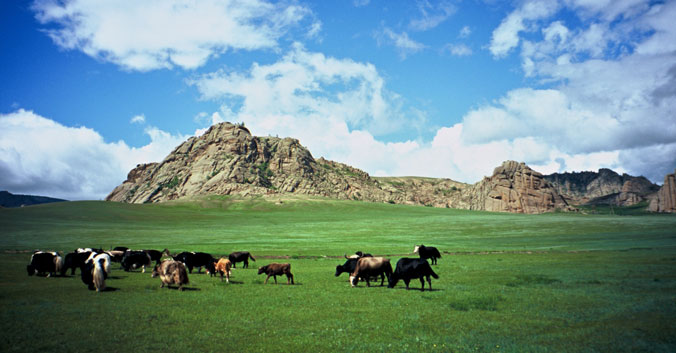Mongolia
Mongolia: The Land of Genghis Khan
Program No. 22965RJ
Mongolia is a must for the intrepid explorer. Admire its limitless beauty as you discover ancient ruins, growing cities and the incredible Gobi Desert.
Itinerary
While we make every effort to ensure the accuracy of our published materials, programs are typically advertised more than a year prior to their start date.
Read More.
While we make every effort to ensure the accuracy of our published materials, programs are typically advertised more than a year prior to their start date. As a result, some program activities, schedules, accommodations, personnel, and other logistics occasionally change due to local conditions or circumstances. Should a major change occur, we will make every effort to alert you. For less significant changes, we will update you during orientation. Thank you for your understanding.
Duration
15 days
14 nights
What's Included
33 meals (
12B, 11L, 10D
)
4 expert-led lectures
20 expert-led field trips
1 flight during the program
4 hands-on experiences
2 performances
An experienced Group Leader
12 nights of accommodations
Taxes and customary gratuity
Road Scholar Assurance Plan
Day
1
Depart North America
Location:
In Flight
Day
2
In Transit to Destination
Location:
In Flight
Day
3
Arrive Ulaanbaatar, Check-in, Orientation, Welcome Dinner
Location:
UlaanBaatar
Meals:
D
Stay:
Best Western Premier Tuushin
Activity Note
Early check in is available on arrival. Remember to bring your nametag (sent previously).
Morning:
For those who arrive on a morning flight, meet your Group Leader at the hotel coffee shop to get acquainted. They will lead you on a short orientation walk of the area before lunch on your own. Group Leader will try to get participants into their room starting at 11am IF the rooms are ready early. Standard check-in is 2pm.
Lunch:
Lunch is independent.
Afternoon:
After you check in and have your room assignment, take some time to freshen up and relax before our Orientation session. Orientation. Group Leader will greet everyone and lead introductions. We will review the up-to-date program schedule, discuss roles and responsibilities, logistics, safety guidelines, emergency procedures, and answer questions. Periods in the schedule designated as “free time” and “at leisure” offer opportunities to do what you like and make your experience even more meaningful and memorable, according to your personal preferences. The Group Leader will be happy to offer suggestions. Program activities, schedules, personnel, and indicated distances or times may change due to local circumstances/conditions. In the event of changes, we will alert you as quickly as possible. Thank you for your understanding.
Dinner:
We will walk to a local restaurant for our welcome dinner.
Evening:
At leisure.
Day
4
Ulaanbaatar, Monastery, History Museum, Throat Singing
Location:
UlaanBaatar
Meals:
B,L
Stay:
Best Western Premier Tuushin
Activity Note
Getting on/off the bus; driving up to 1 1/2 hours pending traffic. Walking up to 2 miles; standing at field trip sites.
Breakfast:
At the hotel.
Morning:
We will board the bus and set out on a full-day field trip through Ulaanbaatar, the capital city of Mongolia. At one time, more than 90 percent of native Mongolians were nomadic herders. Now, almost half of the population lives in Ulaanbaatar. The National Museum of Mongolian History was established in 1991 to document, preserve, and display historical, ethnographic, and cultural artifacts of Mongolia’s ancient heritage to the modern era for a comprehensive look into steppe nomad history and culture. Museum staff will lead our exploration. Used for storage and the staging of a circus in the 1930s, Dashchoilin Monastery was rededicated and reopened in 1990. Here we’ll learn more about Buddhism from a resident lama.
Lunch:
At a local restaurant.
Afternoon:
We’ll visit the International Koomii School in the city center. We’ll learn from an accomplished singer who was a member of Tumen Ekh—the award-winning Mongolian National Song & Dance Ensemble—about Mongolian throat singing and how the singers produce their eerie sounds. A single vocalist can produce two and sometimes three distinct tones, or overtones, simultaneously. We’ll also stop at the Museum of Geology and Minerals, where a local geologist will introduce us to some of what we'll see while on the road.
Dinner:
This meal has been excluded from the program cost and is on-your-own to enjoy what you like. The Group Leader will be happy to offer suggestions.
Evening:
At leisure.
Day
5
Hustai National Park, Neolithic Ongot Monuments
Location:
Hustai National Park
Meals:
B,L,D
Stay:
Mongol Nomadic Ger Camp
Activity Note
Getting on/off a bus; driving about 60 miles, approximately 3 hours riding time; 12 miles of dirt roads, bumpy. Walking up to 2 miles; standing at field trip sites.
Breakfast:
At the hotel.
Morning:
We will check out of the hotel and drive to Hustai National Park.
Lunch:
At the ger camp.
Afternoon:
Hustai is the home of the Przewalski horse, known locally as takhi (pronounced “ta-hee”). The last remaining breed of truly wild horse in the world, they were reintroduced into the wild in 1994 by the Foundation for the Preservation and Protection of the Przewalski Horse in the Netherlands, which flew 16 horses to Mongolia, their historic homeland, 25 years after they had become extinct in the wild. We will visit the Park Information Center and, in the company of a biologist, venture deep into the park to look for the endangered takhi horse. We will continue to the Neolithic Ongot Monuments. Just outside the western border of Hustaii National Park are dozens of gravesites of the Neolithic Turkic Ongot people. Some of the grave markers take the form of short, thickset humans. The oldest graves are thought to be some 4,000 years old.
Dinner:
At the ger camp.
Evening:
At leisure.
Day
6
Mongol Traditional Show, optional horseback riding
Location:
Hustai National Park
Meals:
B,L,D
Stay:
Mongol Nomadic Ger Camp
Activity Note
Walking up to 1 mile, optional horseback ride
Breakfast:
At the ger camp.
Morning:
We will enjoy a Mongol traditional show at the camp. Learn about camp life and culture. Participate in trying local curds and drinks, games and clothes.
Lunch:
At the ger camp.
Afternoon:
The Group Leader will deliver a lecture at the camp on Nomadism in a modern context. Optional guided horseback ride through the beautiful region to follow or time to relax and enjoy the camp.
Dinner:
At the ger camp.
Evening:
At leisure. Prepare for transfer in the morning.
Day
7
Kara Korum, Nomadic Family Visit, Ger Set-up Demonstration
Location:
Kara Korum
Meals:
B,L,D
Stay:
Munkh Tenger Blue Sky Ger Camp
Activity Note
Getting in/out of 4WD vehicles; driving about 175 miles, approximately 5-6 hours riding time; paved roads.
Breakfast:
At the ger camp.
Morning:
We will board our 4WD vans and drive to Kara Korum, the ruined city of Genghis Khan's capital. This UNESCO-listed 13th-century city served as the seat of power for an empire that stretched across two continents. Kara Korum was the capital for only 40 years, before Kublai Khan moved it to Beijing. Destroyed by invading Manchurians, all that visibly remains today is the enigmatic Turtle Rock.
Lunch:
En route to Kara Korum at a ger camp.
Afternoon:
Stopping en route, we will visit with a local nomadic family and learn more about the nomadic way of life. We will see how mares are milked and how Mongolian dairy products are produced, and can take part in these activities. One arrived at our camp, we will witness a demonstration of how a ger is assembled, then lend a hand in setting it up.
Dinner:
At the ger camp.
Evening:
At leisure.
Day
8
Erdene Zhu Monastery, Kara Korum Museum, Calligraphy Center
Location:
Kara Korum
Meals:
B,L,D
Stay:
Munkh Tenger Blue Sky Ger Camp
Activity Note
Getting in/out of 4WD vehicles; driving about 10 miles, approximately 1/2 hour riding time. Walking up to 2 miles throughout the day; standing at field trip sites. Respectful dress (long sleeves, long pants or long skirt, removal of hat) to be observed when visiting the monastery and temples.
Breakfast:
At the ger camp.
Morning:
We will take a field trip by 4WD vehicles to explore the legendary Erdene Zhu Monastery. The oldest Buddhist monastery in Mongolia, it was built in the 1580s using stones from ruined Kara Korum and is inscribed on the UNESCO World Heritage List as part of the Orkhon Valley Cultural Landscape. It grew to include more than 60 temples with 1,000 monks in residence by the late 19th century, but in 1939 the local Communist regime ordered its destruction. Many monks were killed. Only the outer walls and three small temples survived, converted into museums. Erdene Zhu became a place of Buddhist worship again after the fall of communism in 1990. We will converse with a local monk and learn more about Mongolian Buddhism. Next, we’ll take a field trip to the Museum of Kara Korum. Its exhibits—with explanations in English—include artifacts from the 13th and 14th centuries, as well as ongoing scientific explorations. The museum provides a good introduction to Central Mongolia and the UNESCO Heritage Site of the Orkhon Valley Cultural Landscape.
Lunch:
At the ger camp.
Afternoon:
We’ll visit a traditional Mongolian calligraphy workshop at the Erdenesiin Khuree Calligraphy Center and visit the local bazaar where nomads come to get their supplies and chat with local people.
Dinner:
At the ger camp.
Evening:
At leisure. Prepare for transfer in the morning.
Day
9
Ongi Monastery Ruins
Location:
Ongi Monastery ruins
Meals:
B,L,D
Stay:
Ongi Energy Ger Camp
Activity Note
Getting in/out of 4WD vehicles; driving about 175 miles, approximately 6-7 hours riding time; dirt roads. Hiking around the ruins of the original monastery; sturdy walking/hiking shoes recommended. Respectful dress (long sleeves, long pants or long skirt, removal of hat) to be observed when visiting the monastery and temples.
Breakfast:
At the ger camp.
Morning:
We will head south across the Gobi steppe to the Ongi Monastery ruins. During our drive, we will stop for photos along the way.
Lunch:
Enjoy lunch at a local restaurant.
Afternoon:
Tucked away in the dry hills, Ongi Monastery was once among the largest in Mongolia with more than 1,000 monks, before it was razed to the ground during the 1939 Communist purge. Today it is being rebuilt by some of the monks who survived. We will walk around the monastery ruins and visit a new temple built on the ruins of an old one.
Dinner:
At the ger camp.
Evening:
At leisure. Prepare for transfer in the morning.
Day
10
Flaming Cliffs
Location:
Umnugovi Province
Meals:
B,L,D
Stay:
Gobi Mirage Lodge
Activity Note
Getting in/out of 4WD vehicles; driving about 115 miles, approximately 5 hours; dirt road. Hiking about an hour at the Flaming Cliffs; uneven terrain, sturdy walking/hiking shoes are recommended. Sun protection (hat, long sleeves, sunscreen) a must.
Breakfast:
At the ger camp.
Morning:
We start the day driving to the famed Flaming Cliffs, called Bayanzag by nomadic Mongolians.
Lunch:
At the ger camp.
Afternoon:
The Flaming Cliffs are one of the most renowned paleontological sites in the world, where dinosaur eggs were discovered in 1922. The heat and low humidity of this beautiful part of the Gobi have protected and preserved the numerous fossils that have been found here. We will spend about an hour waking around the cliffs taking in the impressive visas and history.
Dinner:
At the ger camp.
Evening:
At leisure.
Day
11
Moltsog Dunes, Camel breeding family, optional camel riding
Location:
Umnugovi Province
Meals:
B,L,D
Stay:
Gobi Mirage Lodge
Activity Note
Getting in/out of 4WD vehicles; driving about 30 miles, approximately 1.5 hours riding time; dirt road, bumpy. Hiking at the Moltsog Dunes requires appropriate dress for sun protection and hiking shoes.
Breakfast:
At the ger camp.
Morning:
Driving through vast desert badlands that stretch out into the distance. Lone gers and nomads on camelback seem to hang suspended in mirages, while the desert floor is strewn with a range of colorful rocks. The Gobi here has a stark beauty and provides many opportunities for photographs of the landscape and people. We'll depart for the Moltsog Dunes, under the force of constant winds, and have the opportunity to climb them. Then meet a camel breeding family. We will learn more about their nomadic culture and those who are feeling adventurous may go for a camel ride.
Lunch:
At the ger camp.
Afternoon:
The Group Leader will deliver a lecture at the camp on the Mongolian Current Economy. Followed by time at leisure.
Dinner:
At the ger camp.
Evening:
At leisure.
Day
12
Yolyn Am Canyon, Archery demonstration
Location:
Umnugovi Province
Meals:
B,L,D
Stay:
Gobi Mirage Lodge
Activity Note
Getting in/out of 4WD vehicles; driving about 30 miles, approximately 1.5 hours riding time; dirt roads, bumpy. Hiking about 3 miles in Yolyn Am Canyon, approximately 2 hours.
Breakfast:
At the ger camp.
Morning:
We’ll make a brief visit at the local museum before stretching our legs on a scenic three-mile roundtrip hike into Yolyn Am Canyon (Vulture's Mouth), which cuts a narrow path into the rocky slopes of the Gurvansaikhan Mountains. Never feeling the warmth of the sun, the cool canyon sometimes shelters snowbanks that remain frozen long into the summer.
Lunch:
At the ger camp.
Afternoon:
After lunch, we’ll have an archery demonstration from a local master archer. Afterwards, try your hand with the bow if you would like.
Dinner:
At the ger camp.
Evening:
At leisure. Prepare for transfer in the morning.
Day
13
Fly to Ulaanbaatar, Genghis Khan Statue Complex
Location:
UlaanBaatar
Meals:
B,L
Stay:
Best Western Premier Tuushin
Activity Note
Getting in/out of 4WD vehicles and on/off the bus; driving 30 miles, approximately 1/2 hour riding time to Gobi airport for flight to Ulaanbaatar. Driving about 50 miles, approximately 1.5 hours from Ulaanbaatar Airport to Genghis Khan Statue Complex, and 50 miles, approximately 1.5 hours from the Statue to the hotel; paved road. Elevator inside Genghis Khan statue, then stairs up to horse-head portion of the statue.
Breakfast:
Breakfast to go in the vans.
Morning:
We will say goodbye to the South Gobi and transfer to the airport for our flight back to Ulaanbaatar. Upon arrival in Ulaanbaatar, we’ll drive to the Genghis Khan Statue Complex. Dominating the horizon, the giant 131-foot stainless-steel-clad equestrian statue of Genghis Khan is an unforgettable sight. Visitors can enter the interior of the horse on an elevator and admire the view from a platform perched on the horse’s head.
Lunch:
At a local restaurant.
Afternoon:
Afterwards, we will transfer to our hotel for check-in. Afternoon at leisure to rest, or explore on your own.
Dinner:
This meal has been excluded from the program cost and is on-your-own to enjoy what you like. The Group Leader will be happy to offer suggestions.
Evening:
At leisure.
Day
14
Chinggis Khaan Museum, Paleontologist, Bogd Khan Palace
Location:
UlaanBaatar
Meals:
B,L,D
Stay:
Best Western Premier Tuushin
Activity Note
Getting on/off a bus; driving about 10 miles, approximately 1.5 hours riding time pending traffic. Walking up to 2 miles; standing at field trip sites. Respectful dress (long sleeves, long pants or long skirt, removal of hat) to be observed when visiting Bogd Khaan Palace.
Breakfast:
At the hotel.
Morning:
We'll walk several blocks to the Genghis Khan Museum, Mongolia’s newest and largest museum opened in 2022. The five-story museum showcases over 10,000 cultural exhibits revealing 2,000 years of history linked to Mongolia’s Great Khans, nobles, nomads, and their statehood from the Xiongnu Empire to the end of the 20th century. Next visit the Institute of Paleontology Research Center for a dinosaur exhibition led by a Paleontologist.
Lunch:
At a local restaurant.
Afternoon:
After lunch we'll visit the Bogd Khaan Palace Museum. Mongolia’s last Bogd Khaan, or Living Buddha, lived for 20 years in this compound, built between 1893 and 1903. Unlike other old sites in Ulaanbaatar, this one escaped destruction in the Stalinist purges of the 1930s. Six temples remain, as does a ceremonial gate built without the use of nails. On display are many of the gifts presented to the Bogd Khaan. Delight in the music and dance performance at the Tumen Ekh Ensemble Folklore Concert before the farewell dinner.
Dinner:
At a local restaurant. Share favorite experiences and enjoy camaraderie with your new Road Scholar friends during our farewell dinner.
Evening:
At leisure. Prepare for check-out and departure in the morning.
Day
15
Program Concludes, In Transit From Program
Location:
In Flight
Meals:
B
Activity Note
6:00 a.m. group transfer to the airport. See your program’s “Getting There” information regarding transfers.
Breakfast:
At the hotel.
Morning:
We’ll transfer to the airport for our international flight home. If you are returning home, safe travels. If you are staying on independently, have a wonderful time. If you are transferring to another Road Scholar program, detailed instructions are included in your Information Packet for that program. We hope you enjoy Road Scholar learning adventures and look forward to having you on rewarding programs in the future. Don’t forget to join our Facebook page and follow us on Instagram. Best wishes for all your journeys!
Please select a day to update the map
Map details are not available for this location.

